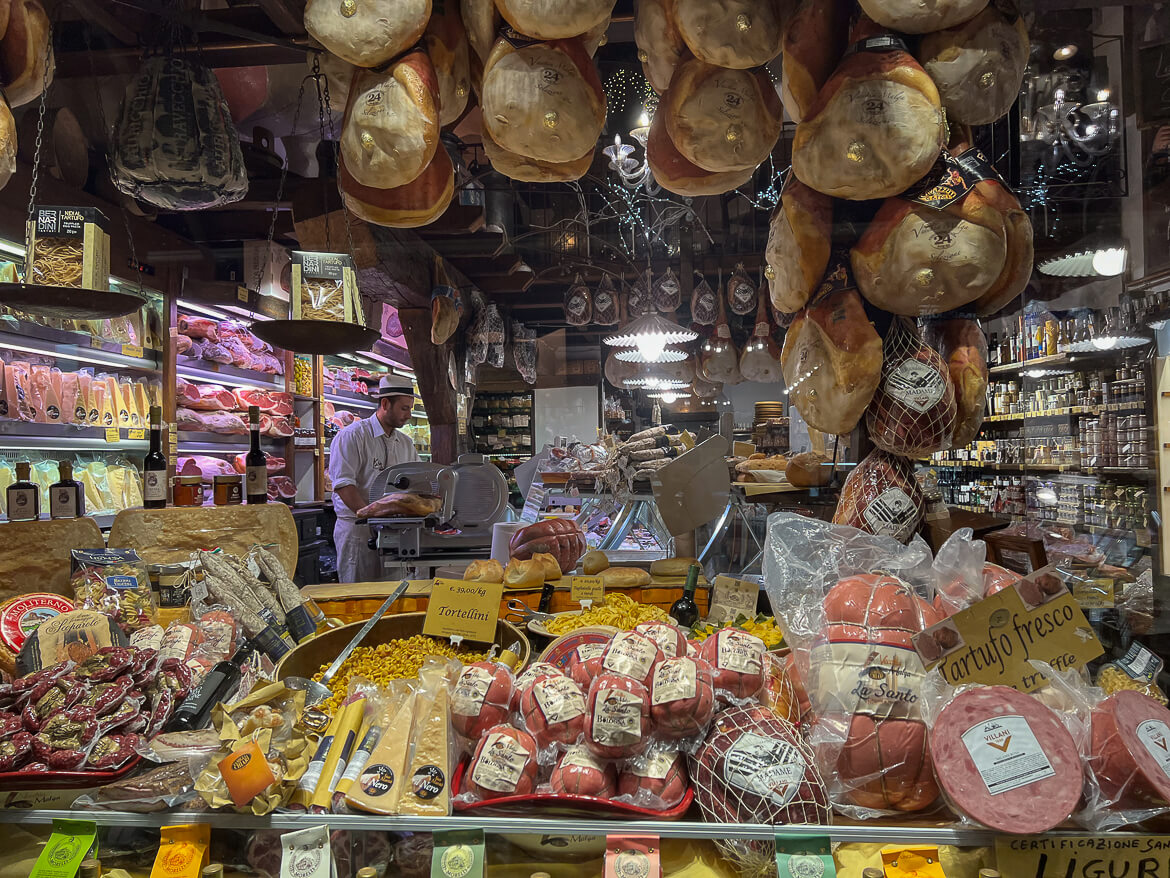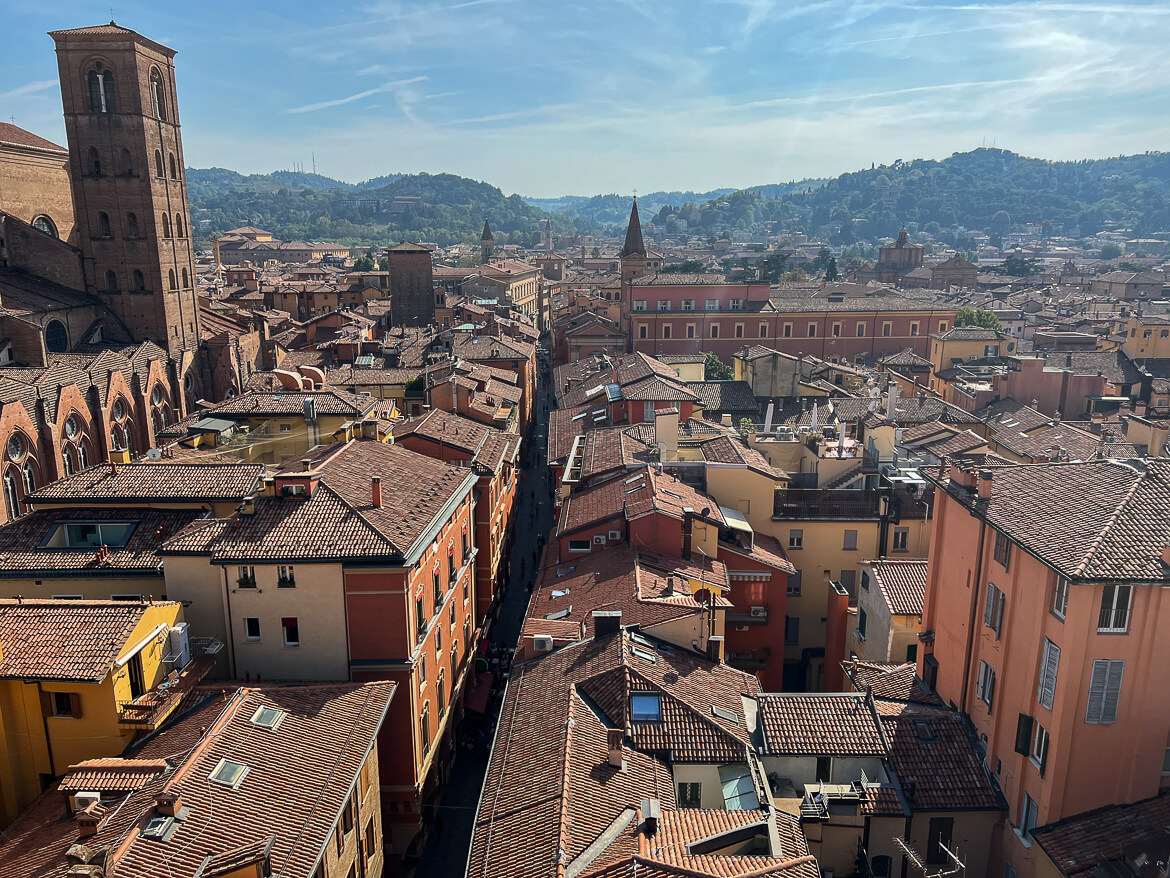A few years ago I took a culinary trip around Emilia Romagna, tasting the many delights the region has to offer. I loved it so much that I vowed to come back as soon as possible and this time I spent the entire time in the region’s capital; Bologna. Bologna is known as the Fat City for its rich cuisine and it certainly didn’t disappoint. I don’t think I’ve ever eaten so well, except for perhaps on my previous trip to the region. From cooking courses to Bologna food tours and lots of meals and snacks in between, my Bologna itinerary was packed with delicious treats. This is how I recommend spending three days in Bologna.

Disclosure: This article contains affiliate links. This means that if you click a link and purchase something I’ve recommended I may earn a small commission. This does not affect the price you pay but helps me to run this site. You can read my full affiliate disclosure here.
Bologna Map
Bologna 3 Day Itinerary
Bologna Itinerary – Day 1
On your first day in Bologna, get your bearings of the city with a food tour. This is a great way to learn about the city’s history, get recommendations on where to go and most importantly – eat! We took a Taste of Bologna Food Walking Tour, organised by the Bologna Visitors Centre. The tour visits various shops selling traditional Bolognese fare including pastries and tortellini, as well as foods from the Emilia Romagna region including Balsamico di Modena and Lambrusco wine. Make sure to ask your guide for their personal recommendations too.

At the end of the 2-hour tour, you are given a voucher for gelato at Oggi Gelato, which we ate later. I’m not exaggerating when I say that this was the best gelato I have ever tasted. And I have eaten a lot of gelato. We returned there multiple times during our trip it was so good.

You’ll want a light lunch after eating all morning (if you need one at all), so make your way to Mercato delle Erbe for some snacks or if you’re hungrier to eat at one of the surrounding bars and restaurants. This is the largest covered market in Bologna, selling fruit, vegetables, meat, cheese, wine and more, along with a food court.
In the afternoon head to the Bologna University district and visit the oldest university in the Western world. Established in 1088, the university houses 14 museums, including collections of natural history, anatomy, geology and nautical science along with a Museum of Zoology and an Astronomy Museum. The neighbourhood itself is also lovely to wander and there are tours of the district if you want to know more about the University’s history and its strong connection to the city.

For dinner, head to what I think is the best restaurant in Bologna – Osteria Della Lanterna. Or at least it’s my personal favourite! The restaurant serves traditional Bologna cuisine and has been running for over 50 years. If you’re visiting on the weekend then make sure to try the lasagne – made the Bologna way with green pasta. Everything on the menu is made from scratch and the food is incredible.

Bologna Itinerary – Day 2
(Note – if you prefer to get out of the city and see more of the region, then swap this day with the itinerary for day 4, later in the article).
On day two of your Bologna food extravaganza head to Allegra first thing for coffee and pastries. It’s not your typical Italian coffee bar and is resemblant of a Melbourne cafe. They even do flat whites! The pastries are delicious with unusual combinations like lemon merengue croissants alongside the most indulgent pain au chocolat. Yum.

Make your way to the Quadrilatero, an area of narrow streets filled with food shops and restaurants selling food from Bologna and the rest of Italy. The area is essentially Bologna’s oldest market and food producers and sellers have operated here since the Middle Ages. You will have passed through the Quadrilatero on the food tour yesterday, so now is the time to enjoy it at a slower pace and stock up on any treats you might wish to take home.

One of the most famous and atmospheric streets in this neighbourhood is Via Pescherie Vecchie. Head here for lunch at Osteria Zerocinquantello (051 Bologna) which has some great outdoor seating opposite shops selling cheese and prosciutto. The menu features traditional Bologna dishes like tortellini in brodo (tortellini in broth) along with delicious charcuterie boards of local produce.

Spend the afternoon wandering through Bologna’s Porticoes, which are a UNESCO World Heritage Site. There are 62km of them to explore, including wooden ones, such as the 13th century wooden casa Isolani in Strada Maggiore and the longest in the world, Portico San Luca. If you are feeling energetic you can take the 50 minute walk under 666 arches that lead to the Santuario di Madonna di San Luca, a beautiful church on a hill overlooking the city. If you don’t fancy the walk there is also a tourist bus called the San Luca Express that takes you up to the top.

In the evening, have dinner at Sette Tavoli, an excellent Bologna restaurant that has a monthly changing menu of creative Italian in a lovely setting. Alternatively, if you fancy something a little more low key then head to Pizzeria da Michele, in bustling Piazza San Martino. One of the best restaurants in Bologna for pizza.
Bologna Itinerary – Day 3
On the final day head to Il Salotto di Penelope for a Bologna cooking course. Here you will learn how to prepare some of the city’s traditional dishes such as tagliatelle al ragu and tortelloni. I cook a lot of Italian food, including ragu but I learnt so much about the history of the dish and the official way to make it on this course. Once you have prepared the dishes – you get to sit down with a glass of wine and eat them which we very much enjoyed!


After all the food from the morning, you will want to stretch your legs in the afternoon, so it is the perfect time to climb a tower. The two towers: Garisenda and Asinelli are one of Bologna’s most famous tourist attractions. Previously it was possible to climb the 498 stairs of Torre degli Asinelli for spectacular views, however, at the time of writing the tower is closed for maintenance. The good news is, that you can still see incredible views over the city from Torre dell’Orologio instead (and there are much fewer stairs to climb). The tower is located on Piazza Maggiore and provides an informative guide to the history of the building while you climb to the lookout at the top. The entry ticket also includes access to the Municipal Art Collections which are well worth a look.

After eating lots of pasta in the morning, you’ll probably want a bit of a change for dinner, so head to Osteria Bartolini. This restaurant specialises in Romagna seafood and has the most incredible setting on the grounds of a former palace. I really do think it’s the most beautiful restaurant in Bologna.

4 Days in Bologna
If you have an extra day to spend in Bologna then I recommend heading out of the city to see some of the beautiful countryside and food producers or visiting one of the other nearby cities such as Modena, Parma, Ferrara and Reggio Emilia.
There are lots of great day tours from Bologna that will take you to visit a Parmigiano Reggiano factory, an acetaia (a balsamic vinegar producer), wineries and more.

Modena
Another great foodie city, this is home to lots of excellent restaurants including Osteria Francescana which has been awarded the title of best restaurant in the world multiple times. (Book in advance). Don’t miss the market, the UNESCO Cathedral and the Grand Piazza. It is also the birthplace of Lucio Pavarotti and you can visit his former home Casa Museo Luciano Pavarotti just outside the city.
What to eat: Balsamico di Modena

Parma
The second largest town in the region is home to a stunning Duomo, Baroque churches and excellent museums. It is also the birthplace of some of Italy’s most loved foods; Parmigiano Reggiano and Prosciutto di Parma.
What to eat: Parmigiano Reggiano and Prosciutto di Parma

Reggio Emilia
Known as the birthplace of the Italian flag, Reggio Emilia is less touristy than the neighbouring cities but it’s well worth a visit with beautiful piazzas, parks and lots of lovely places to eat.
What to eat: Erbazzone – Two layers of pastry filled with chard, spinach, onions, lard and Parmigiano Reggiano.

Ferrara
The Renaissance city of Ferrara is a UNSECO World Heritage Site. Discover impressive palaces and castles and walk the medieval walls and streets of the beautiful city.
What to eat: Pasticcio di Maccheroni (a macaroni pie)
You can read more about these cities and the rest of the region in my Emilia Romagna itinerary.

Other Things to Do in Bologna
FICO World Eataly is an Italian food theme park located just outside Bologna. With tours, cooking courses, a farm and food history-related exhibitions, the park is a great place to learn about Italian cuisine. Shuttle buses run from Bologna city centre each day.
Save some time to enjoy an aperitivo in one of the city’s many bars. We loved Enoteca Storica Faccioli for natural wines and Enoteca Italiana – a wine bar/shop with plates of local cheese and cured meats.
Where to Stay in Bologna
I always prefer to stay in an apartment on a city break, so I can make my own breakfast (something I find especially important in Italy as there isn’t much of a breakfast/brunch culture). Fortunately, there are lots of great apartments in Bologna to rent, but some lovely hotels too if that’s your preference.
Budget – Suite del Borgo – Affittacamere is a great budget accommodation in Bologna located just outside of the University district. The studio has air-conditioning and free WiFi.
Mid-range – I had a great stay at Residenza Ariosto by Studio Vita, which offers a variety of studio, one and two bed apartments in a historical building in the centre of Bologna. They have fully equipped kitchens, air conditioning and free WiFi.
Luxury – Another central Bologna accommodation, the 4 star Portobello Apartments has one and two bed apartments, some over two stories and with terraces.
Super Luxury – The Grand Hotel Majestic “già Baglioni” is the oldest hotel in Bologna. The prestigious 5 star hotel is set within Located within an 18th-century palace in the centre of the city. The spacious rooms are decorated with frescoes and antique furniture.

How to Get to Bologna
Bologna Guglielmo Marconi Airport is an international airport with direct flights to the UK and other European cities. It’s quick and easy to get from Bologna airport to Bologna Central Station on the Marconi Express, a monorail service that takes 7 minutes and runs regularly from 5:40am to midnight each day.
Italy has an excellent high-speed train network which I highly recommend if you’re travelling within mainland Europe. Or you can connect from the UK via the Eurostar. From the central station, it takes about 20 minutes to walk to the centre of the city.

Getting Around Bologna
The centre of Bologna is fairly small and it’s easy to get around on foot. Like many Italian cities, Bologna has a Limited Traffic Zone in the Historical Center (ZTL), which means that vehicles have restricted access between 7:00 to 20:00 every day. There is also an efficient Bologna bus network.
